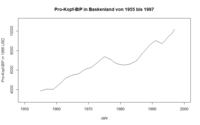Economy of Wales
[25] This led to the Wales Act 2014, which devolved a range of provisions to the National Assembly, including powers over taxation.
Fiscal and economic policy are currently reserved matters determined at Westminster, however from 2018 increased tax and borrowing powers devolved.
They also note the view of some that the historic exploitation of Wales and its treatment as an economic periphery plays have implications today.
[30] According to the Welsh Government's economic development strategy published in 2005, the role of the public sector in the economy is to help create a stable and favourable business environment, promote skills and innovation (through for example apprenticeships and Design Wales), address market failures and invest in economic infrastructure including transport and information technology.
Cooke suggested that a relatively weak devolution settlement had prevented the Welsh Government from developing innovative economic policies, especially when compared to Scotland.
[32] However, critics including former Welsh Secretary Ron Davies and John Lovering, another Cardiff academic, claimed that Cooke's argument that a more powerful Assembly was a necessary precondition to more effective economic policies was a non-sequitur.
[30] The economists Nicholas Crafts and John Bradley have argued that the Irish Celtic Tiger model, which includes lower corporation tax rates to stimulate investment and growth, was only effective in the very specific demographic and historical circumstances of Ireland in the late 1980s and 1990s.
The authors say that this was achieved by using a strategy focused on industry over multiple decades with "close co-operation among all levels of government and between the public and private sectors".
[38] 1.6m hectares (around 77% of Wales' total land area) is used for agricultural production and an estimated 57,500 people are directly employed in the sector.
[39] Banc Cambria is a proposed national Welsh community bank currently under development and aimed to be operating in Wales by 2023.
[45][46][47] In 2021, the Welsh government said that more than half the country's energy needs were being met by renewable sources, 2 percent of which was from 363 hydropower projects.
NHS Wales provides healthcare to all permanent residents that is free at the point of need and paid for from general taxation.
[51] Though the public system dominates healthcare provision, private health care and a wide variety of alternative and complementary treatments are available for those willing to pay.
[56] General Electric (GE) on Caerphilly Road, Nantgarw in Wales handles the world's largest and most fuel efficient aviation engine, GE9X.
[59] During the 1980s and 1990s, a major growth sector in manufacturing was the electronics industry with over 130 North American and 35 Japanese companies establishing operations in Wales.
The company produces specifically industrial gauges, ultrasonic level transmitters, temperature probes and pressure measurement equipment.
The company has delivered high-profile work, including collaborative projects such as the London Olympic Stadium Transformation and ICC Wales’ 22 tonne steel Welsh dragon.
[60] TIMET has a plant in Waunarlwydd, Swansea, which is one of the world's major suppliers of titanium for jet engine blades and medical applications.
[h][67] The minor role that the Welsh industry holds is largely due to its geographical isolation, weak distribution networks and the demise of the Wales distant-water fleet from the 1960s onwards.
[68] In recent years, the service sector in Wales has seen above average growth; however in 2005 its share of GVA was small compared with most other regions of the UK.
[60] Wales does not have a favourable occupational structure, and a relatively high proportion of jobs are in public administration, health and education.
Excluding intra UK trade, the European Union and the United States constitute the largest markets for Wales's exports.
Recently, with the high rates of growth in many emerging economies of southeast Asia and the Middle East such as China, UAE and Singapore, there has been a drive towards marketing Welsh products and manufactured goods in these countries, with China and Qatar entering the top ten destinations for Welsh exports in 2013.
Mid and North Wales (away from the coast) are served by a limited number of branch lines, some of which connect with revived narrow gauge railways.
[90] Hafren Dyfrdwy is a company providing water and wastewater treatment services, operating in north east and mid Wales.
[31] A significant part of the earnings (and value added per job) variations within Wales are due to structural factors such as economic mass and occupational mix rather than like-for-like lower pay or productivity.
[31] Cardiff, with over 400,000 people, benefits from its size, capital status, a hinterland in south east Wales and good connections to London and the M4 corridor.
[92] North east Wales benefits from proximity to Cheshire, Greater Manchester and Merseyside and there is significant cross-border commuting.
Many parts of Wales suffered from a continuous decline in heavy industry over the 20th century, culminating in the virtual disappearance of coal-mining in the 1980s.
Merthyr Tydfil and Neath Port Talbot have some of the largest proportions of people in the UK not working due to long-term illness or disability, though some believe that in reality many people classified as "unable to work" through sickness are low-skilled workers encouraged to exit the labour market by the benefits system as well as declining demand for their skills.






